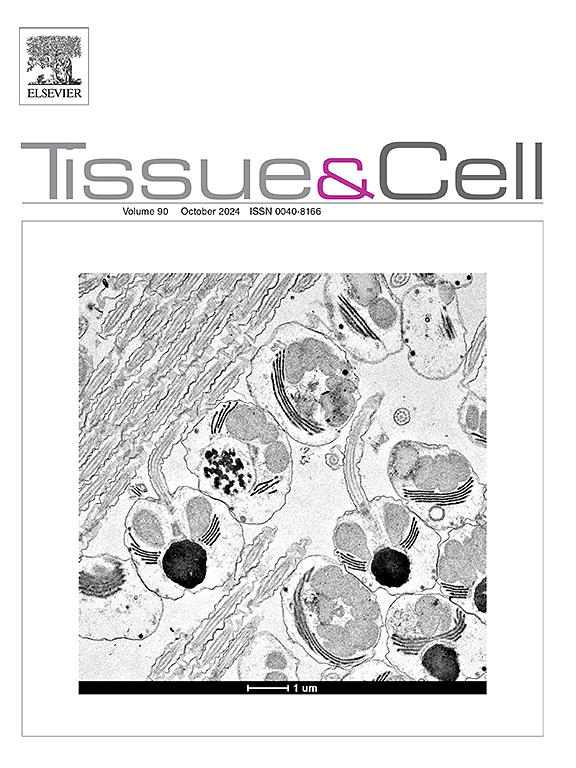Linoleic acid induces migration and invasion through TLR4 in breast cancer cells
IF 2.7
4区 生物学
Q1 ANATOMY & MORPHOLOGY
引用次数: 0
Abstract
Breast cancer is the most diagnosed cancer and the leading cause of cancer-related deaths among worldwide women. Linoleic acid (LA) is an essential omega-6 polyunsaturated fatty acid and the most common polyunsaturated fatty acid in Western diets. Particularly, overweight and obesity are risk factors for breast cancer development in postmenopausal women. LA stimulates an elevation in PLD activity, as well as promotes migration and invasion in MDA-MB-231 breast cancer cells and an epithelial-to-mesenchymal transition process in MCF10A cells. Toll-like receptors (TLRs) are a group of type I transmembrane receptors that have been linked with cancer progression in various types of tumors, including breast cancer. TLR4 is expressed in immune cells, epithelial cells and breast cancer cells, and an inhibition of TLR4 expression in MDA-MB-231 cells promotes a decrease in their viability, proliferation and the secretion of IL-6 and IL-8. This study demonstrates that LA stimulates migration through TLR4 activity in MDA-MB-231 and MCF-7 breast cancer cells. Moreover, LA promotes FAK activation, focal adhesion assembly, an increase in MMP-9 secretion and invasion through TLR4 activity in MDA-MB-231 cells. Our findings demonstrate a signal transduction pathway in which LA activates FFAR1/FFAR4, which in turn activates TLR4 leading to the regulation of specific cellular processes, such as migration and invasion in breast cancer cells.
亚油酸通过TLR4诱导乳腺癌细胞迁移和侵袭
乳腺癌是全世界妇女中诊断最多的癌症,也是癌症相关死亡的主要原因。亚油酸(LA)是一种必需的-6多不饱和脂肪酸,也是西方饮食中最常见的多不饱和脂肪酸。特别是,超重和肥胖是绝经后妇女患乳腺癌的危险因素。LA刺激PLD活性的升高,促进MDA-MB-231乳腺癌细胞的迁移和侵袭,以及MCF10A细胞的上皮到间质转化过程。toll样受体(TLRs)是一组I型跨膜受体,与包括乳腺癌在内的各种类型肿瘤的癌症进展有关。TLR4在免疫细胞、上皮细胞和乳腺癌细胞中均有表达,抑制MDA-MB-231细胞中TLR4的表达可促进其活力、增殖和IL-6、IL-8分泌的降低。本研究表明,LA通过TLR4活性刺激MDA-MB-231和MCF-7乳腺癌细胞的迁移。此外,LA通过TLR4活性促进MDA-MB-231细胞中的FAK活化、局灶黏着组装、MMP-9分泌增加和侵袭。我们的研究结果证明了LA激活FFAR1/FFAR4的信号转导途径,FFAR1/FFAR4反过来激活TLR4,从而调节乳腺癌细胞的特定细胞过程,如迁移和侵袭。
本文章由计算机程序翻译,如有差异,请以英文原文为准。
求助全文
约1分钟内获得全文
求助全文
来源期刊

Tissue & cell
医学-解剖学与形态学
CiteScore
3.90
自引率
0.00%
发文量
234
期刊介绍:
Tissue and Cell is devoted to original research on the organization of cells, subcellular and extracellular components at all levels, including the grouping and interrelations of cells in tissues and organs. The journal encourages submission of ultrastructural studies that provide novel insights into structure, function and physiology of cells and tissues, in health and disease. Bioengineering and stem cells studies focused on the description of morphological and/or histological data are also welcomed.
Studies investigating the effect of compounds and/or substances on structure of cells and tissues are generally outside the scope of this journal. For consideration, studies should contain a clear rationale on the use of (a) given substance(s), have a compelling morphological and structural focus and present novel incremental findings from previous literature.
 求助内容:
求助内容: 应助结果提醒方式:
应助结果提醒方式:


